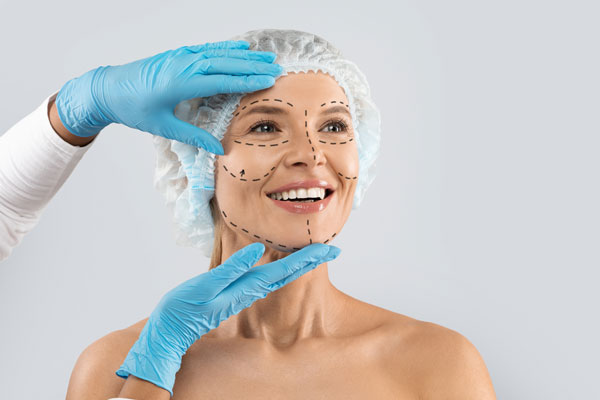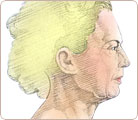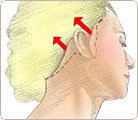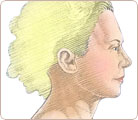Cecilia R.
From the initial and very thorough consultation with Dr. Kreidstein you know you are with an exceptional surgeon who has a keen eye that enables him to produce incredible results. All of the staff and nurses put you at ease, inform you clearly and you feel very well looked after. I am medically trained and research anything for years before I make a choice and twice a decade apart Dr. Kreidstein and his staff were my first choice for my surgeries.
Eyvette H.
Very happy with the service and procedures
Joanne B.
My visit was a consult only. I look forward to further communication with Dr. Kreidstein and staff to assist in making my final decision.
Davida K.
I went to Dr. Kreidstein's office for the first time ever. I heard he was amazing and wanted to talk to him about removing the extra skin off my eye lids. By the time we were finished our appointment, I was ready to book an appointment for the procedure. The doctor was wonderful. He is honest, knowledgeable, and straight forward. He has a great way of making you feel as though you chose the right guy to do the job. I thought the reception staff was outstanding. I only got Julia's name but there were two. They are unbelievable. They did everything they could to make me feel comfortable. They were very nice and I must say as helpful as could be. Needless to say, the visit was a success from beginning to end.
Elzbieta K.
Professional, punctual, informative, pleasant. I am looking forward to having a procedure done by Dr. Kreidstein.
Ruthe R.
I felt extremely well taken care of at every step. Every question was answered by the doctor in a way that made me very confident. They whole team are just wonderful and I am thrilled with my results.
Cecilia R.
Helpful and friendly staff! I saw Dr. Kreidstein for an extensive body contouring procedure eleven years. I have come back to consult on a medial thigh lift and there is no one else I would trust to go too. I respect his skilled art and science approach,
Margaret G.
Dr. Kriedstein and staff are nothing short of stellar. Deanna and Julie are warm and welcoming. They knew I traveled from Ottawa to see them, and tried to accommodate me in order to make everything as easy as possible. Dr. Kriedstein himself is laid back and easy to speak with. He's knowledgeable, cautious, and holds your best interests above all else. I felt welcome, safe and well taken care of. I would recommend this office to anyone without hesitation.
Carla P.
I enjoyed Dr. Kreidstein's time and professional opinion. He made me feel very comfortable during my consultation with him.
Valerie S.
I felt extremely comfortable and safe in the hands of Dr.Kreidstein and his staff at the clinic. From the start of my consultation, to the day of surgery, to my last check-up appointment, everyone really took their time to care about my needs, answer my questions, and make me feel at home. I was referred to Dr.Kreidstein by a friend, but after researching plastic surgeons in Toronto, I was pleasantly surprised to see him on the list of top surgeons in the city. I chose him, and I am so glad I did. He gave me exactly what I wanted, and reassured me even through my nerves. On the day of my surgery I was extremely nervous, but Dr.Kreidstein and his staff made me feel extremely settled, calm, and they took their time to answer all of my many questions. Following the surgery, his staff took their time to check in on me and see how recovery was going. I felt very cared for to say the least. Thank you Dr.Kreidstein and team for giving me the results I've always wanted!
Shirley C.
I’m very please with the results from the liposuction. After 2 months, my body is healing nicely , looking already the way I wanted. Dr. Kreidstein and his staff were very nice since day one and through all this process. I highly recommend his practice , knowledge and professional skills. Thanks
Sherri P.
An amazing surgeon. Absolutely meticulous. 5 stars!
Naomi M.
Dr Kreidstein is very knowledgeable, answers all your questions and never makes you feel that any question is a stupid one. Dr. Kreidstein takes the time to explain the procedure and what the outcome will be. The team at the office are very friendly, helpful and caring which adds to your visit.
Brianna K.
Dr. Kreidstein and team are not only professional, but they treat you like family. I've had experience with many doctors who come off cold, but they are warm, caring and welcoming. From an artistic stand point, Dr.Kreidsteins eye for symmetry, precision and natural perfection is quite outstanding. I have had the most incredible reconstructive transformations in many areas on my body, and I owe it all to my sculptor. I am especially pleased with the way Dr.Kreidstein does his job ethically. If he feels a decision is unsafe, or unnecessary he let's you know without you feeling "dumb". He really cares. His entire team does, and they care for you to the best of their ability on surgery day so that you are both calm and informed. Follow up care is just as great. They want you to have the best experience possible! Thank you Team. I'm excited to be in your care again in the future, your work is Phenomenal. Brianna Kelly
Cynthia U.
Doctor was very good at outlining the procedure risks and what is best for me as an individual. I was very impressed with how I was treated and would recommend his services to family and friends. Staff was excellent at answering questions and returning my calls over all a great experience.
Daphne F.
Dr. Kreidstein is so supportive and always promptly follows up when I call. I know I am in good hands.
Claudine W.
Any cosmetic procedure should only be done by the best qualified surgeon, for that reason I stay faithfully with Dr.Kreidstein.
Deborah S.
I feel very comfortable with Dr. Kreidstein. He builds trust and has time for his patients
Ika F.
Clean environment, good service, no wait time, just thumps up all th way. Good customer service, friendly staff I recommend anytime..
Radu B.
Extremely easy to talk to. Patience to answer all questions. Very detailed explanations on what can be done about procedures.
Tonya B.
Only a couple weeks post op but can’t say enough about the care and communication received. From the staff in the office, my nurses beside and for follow ups to Dr. Kreidstein replying to every inquiry and concern I had very quickly. Not to mention so far everything looks great!
Alice P.
Dr. Michael Kreidstein and his entire staff have been outstanding throughout the entire process. When I initially went into the office for a consultation I knew what I hoped to accomplish but had no idea of what to expect. My questions were answered and I was very comfortable with the professionalism but still felt there was humanity and understanding with my hang ups. My surgery was scheduled, with accommodations made for all my needs from holiday time through where I live in accordance to the office. The surgery itself has exceeded my expectations. It has only been two weeks and I already see positive results. I would be happy to recommend Dr. Kreidstein to anyone.
Hedy C.
Superior attention and excellent service. Have had many procedures done by Dr. K and I have very high expectations - all expectations are either met or exceeded. Honesty in all dealings and a commitment to a natural look are what to expect.
Adianiz G.
Great consult answered all my questions
Elizabeth S.
Staff is very friendly and courteous. Dr. Kreidstein himself, was very thorough and honest in his assessment of my problem. He answered all my questions and was concerned about my overall health and discussed all issues relating to surgery. At no time did I feel rushed..I am so happy I chose him to do my surgery.
Susan A.
Dr k was so great. He told me the truth about what results I could expect and answered all my questions. His staff was wonderful answering any little question I had when I called. The results of my lower body lift were so much better than I could have hoped for. I am looking forward to working with Dr K in the future on my second surgery. Wonderful clinic and so happy that I found him
Adrian K.
Excellent surgeon. Very grateful for his attention to the carpal tunnel in my left hand. The operation was successful and a huge relief.
Maha I.
Well organized team. Everyone is professional, thorough and there for you. And this helps especially during recovery period.
Naomi M.
Dr. Kreidstein and Staff are welcoming from the moment you step through the door. Dr. Kreidstein has an endless amount of knowledge and will answer all your questions in a professional manner as well as being non-judgemental and providing you with honest answers. Dr. Kreidstein will advise on the best course of action to your goals and will not recommend anything unnecessary. If you want someone who is up to date with the newest treatments and courses of action BOOK NOW you will be glad you did.
Wasnaa Y.
Dr Kreisstein is one of the best plastic Sergion doctors in Canada. I trust his opinion blindly and recommend him to everyone who wants to look better and healthier. Thank you so much doctor Kreidstein for being our favourate doctor.
Leslie P.
Dr Kreidstein is such an excellent doctor! It’s a wonderful feeling to have a doctor you know you can trust to give a beautiful Botox/ filler treatment. I have been going to him for years and I’m always very happy with the results. I always look refreshed and natural.
Alice P.
Courteous, informative, professional with positive feedback and a great sense of humour.
Deborah R.
Front desk was very nice. Doctor explained everything well.
Deanna B.
100% happy with my experience with Dr Kreidstein and his staff. Everyone was so kind and so helpful through my process.
Ritchelle R.
Very helpful friendly and very professional!
Fred S.
The best from the front office to the surgeon.
Eunice S.
I have been to many many consultation, and I can say this is the best, the doctor was very easy to talk with, he listened to what I was saying and explained everything step by step and he make sure that I understood everything, there was no rush in explaining anything, the best so far, talk about the ladies who works there, out of this world nice, I felt like I had known them a long time ago, they treat you with respect, they can teach others workers how people should be treated in an doctors office.
Tonya B.
Went in for first consult and was very nervous, staff and doctor were very down to earth, easy to talk to and welcoming. Facility is very well kept and overall experience was great! Looking forward to proceeding with this team!
Susan A.
I felt so confortable and there was no pressure. All my questions were answered and the office staff was so nice.
Laurie H.
Very professional and helpful
Jill S.
As a patient of Dr. Kreidstein for over ten years, with complete confidence I can attest to his and his staff’s professionalism, courtesy, consideration, friendliness, helpfulness, prompt service, and the list goes on. I have referred numerous friends and acquaintances to Dr. Kreidstein. Each and every one, after meeting him, chose Dr. Kreidstein as their physician and each and every one was satisfied and happy with their choice. Thank you Dr. Kreidstein and staff!!!
Brenda C.
I have had several procedures with Dr. Kreidstein, and have been very happy with his care, knowledge and finesse. He made every effort to fully understand my wishes and desired outcome. I was very happy with the results of my surgeries, and they improved my self image a great deal. His staff is very attentive and professional.
Bonnie G.
The lesser rating has nothing to do with the office or the Dr but more about my personal privacy and even a bit about cost
Carol H.
Dr. Kreidstein is thorough, knowledgeable, and friendly. He is willing to go above and beyond for his patients. Secretaries are outstanding and kind. Highly recommended!
Melissa W.
Hi all, I visited Dr. Kreidstein’s office April 25 for my consult re : liposuction of flanks. During my consultation, we discussed my wants as well as potential complications from proposed surgery. While there Dr.K suggested “fat graphting” ultimately the fat removed transferred to another area where it would actually be wanted and welcomed. I never thought of it and I am so glad he suggested it disclaimer “I don’t want to try and upsell you,” as per Dr.K. Once suggested it just made more sense, I mean from an aesthetic view and overall feel.This is the doctor you guys need to go to!He is honest,and made me feel totally comfortable during the entire process. The entire team, I mean easy to talk to,personable,made the entire experience a good one.Ergo,my surgery is now scheduled for June 14! I cannot wait 😊Thanks to the Dr.Kreidstein and his A-1 team #thankMElater
Thomas M.
Dr Kreidstein was extremely professional and informative. He backed up all his opinions with 'real world' experience from his extensive work in the field. I appreciated his candor and honesty
Jennifer T.
The Dr is amazing I walked in very very nervous. Walked out happy and calm
Elena D.
After seeing 3 different plastic surgeons re. my lower face and neck lift, I desided to book my surgery with dr. Kreidstein. He made me feel very comfortable at the first consultation, so I didn’t even think twice. I’m excited and looking forward to my upcoming transformation. Will update you with the results.
Savita K.
Loved the service and post op care
Kimberly E.
Always a pleasant experience when seeing everyone at the Kreidstein office! I recommend Dr. Kreidstein with full confidence to my closest friends and family for top notch excellence in cosmetic surgical and non surgical procedures.
Christine M.
No words can describe how pleasant this whole experience was! Dr Kreidstine is a very kind and honest surgeon. Every person of the staff is very professional and friendly as well. Highly recommended clinic. I’m very pleased with my results and my decision to go to Dr Kreidstine.
Colleen B.
I just can't say enough great things about this clinic. I've had several procedures done by Dr. Kreidstein and have been extremely happy with the results. He is a very dedicated and intelligent Doctor, who is well educated with many different treatments. He is truly open and honest about what he's able to do for you, and what the outcome will be. All of the staff here are incredibly friendly and accommodating, very refreshing for a plastic surgery clinic. I personally wouldn't trust another plastic surgeon to meet my needs!
Iftekhar K.
Dr. MICHAEL, Is an amazing cool professional doctor. I can say he is awesome. He will hear you out and explain all possible and options Nd let you decide what you want to do or feel like no rush h no push. I guess i met an amazing doctor and i will visit him always.
Mihaela C.
Really pleased with Dr Kreidstein and his staff!!!!!!!!!! I truly believe he is a great doctor!
Douglas M.
Awesome experience beginning to end. Thanks
Toni C.
The staff treat you wonderful and are so helpful. The Doctor is very kind and has good bedside manner. Although baring my most shameful body parts was a very difficult and vulnerable feeling, it could have been absolutely traumatic had the Doctor not been as sensitive as he was. Thank you all
Naomi M.
Dr. Kreidstein and staff are always warm and welcoming. Dr. Kreidstein answers all your questions which helps you make an informed decision. I highly recommend no matter what you are having done whether its mole removal or something more.
Sahameh D.
I am very happy with the result of surgery on breast and abdonim, Dr kreidstein is experienced and reasonable
Angela K.
I felt very comfortable with the Doctor and staff from the initial consult, and throughout the whole process. The results were amazing and my every need was taken care of.
Christina S.
Very informative and detail orientated consultation with all questions answered with assurance that there is a good understanding of the procedure. Helpful and kind support staff as well.
Shelley B.
I have 2 surgeries preformed by Dr. Kreidstein and I have been treated very well by both the doctor and all of the office and surgical teams both times. I would definitely send someone his way if they were in need of a surgeon .... Thank you so much......
Leslie P.
Dr Kreidstein was, as always very professional and is a very nice doctor. I love the results from my filler treatment that he did for me. I like how I can trust him to know exactly what I need to look my best. I look completely refreshed but I still look like me. I'm always afraid of being overfilled like some of the celebrities I see but Dr Kreidstein made me look great and very natural. I like the secure feeling I get from knowing I'm in good hands. His staff is really nice too!!
Ruth K.
Dr Kreidstein was very cautious and explained options. Very nice staff and overall a very pleasant experience.
Joy K.
I've had 2 different procedures done now by Dr. Kreidstein and I had an excellent experiences both times. The staff is very welcoming and informative and Dr. Kreidstein is an absolute artist; he was very approachable with any questions I had and his responses reflected how much experience and knowledge he has. A friend recommended me to him and I'm so glad she did!
Susanne P.
After losing 279 lbs I had lots of hanging loose skin and excess fat. I also had very low self esteem, felt ugly and miserable. I can't thank Dr. Kreidstein enough for working his magic to make me feel so much more confident and proud of my weight loss journey. Never once did I feel embarrassed or judged by him. He listened to me, explained everything thoroughly and I knew I had put my trust in the best surgeon, I felt safe. Two procedures have been done and I couldn't be more amazed or thrilled. His pre and post surgical care is second to none in my opinion, he made me feel like I was important not just another patient and honestly I wouldn't trust any other plastic surgeon with my care, I felt comfortable the first time we talked and during follow up visits as well. He never rushed through appointments and quickly responded to emails. I can't say enough good things about both his care and his wonderful staff. I have highly recommended him to many colleagues and friends and will continue to do so. Dr Kreidstein thank you so much for giving me my life back and a healthier life to look forward to. The compliments I receive make me sure I made the right choice in my surgeon and made it all worthwhile. Looking forward to another procedure in 2018.
Jennifer C.
Always amazing from start to finish not all about the sale and annoying like some surgeons just does an excellent job and takes care of the patient's health
Susan S.
I had the best liposuction experience. I thought I needed a breast reduction but Dr. Kreidstein suggested liposuction would be a better option. It was - it was less invasive, had no pain level, no scars and quicker healing. I did not have to take any pain killers- not even Tylenol. It also provided me the ability to return to my normal life and exercise within a two week period instead of a 6 week plus period. i would highly recommend this procedure. I would highly recommend Dr Kreidstein as well. He is patient and understanding. He takes the time to explain the procedure and suggest what he thinks is the best course of action. He is always available to answer any questions and I never felt rushed or pressured. Plus he has a wonderful staff! Always a bonus. I can not praise the experience enough. And, the fact that I am extremely satisfied with the results speaks for itself.
Colleen B.
This clinic goes above and beyond! The staff are very helpful with booking appointments, promptly answering questions and following up with procedures that you have had. Dr. Kreidstein is one of the most knowledgeable plastic surgeons I have ever met. He will tell you if a product/procedure will or won't work for you, and suggest an alternative if it won't. He's extremely ethical in his practice and will never try to push a procedure or product on you (a rarity in this field I might add). I highly recommend this clinic, my experiences have all been extremely positive.
Angela K.
I felt very comfortable in Dr. Kreidstein's hands. He was very knowledgeable and explained things very well. His staff were very pleasant and welcoming. It was a very positive experience!
Debbie S.
I have used Dr. Kreidstein's services and recommended him to friends. He has a keen eye for ensuring results are natural. He and his staff are very friendly and make you feel at ease. I will continue to recommend his services. Dr. Kreidstein's staff are very friendly and encouraging with have genuine job satisfaction.
Shayne D.
I was thrilled with the results of my chemical peel. I have been told I knocked a good ten years off with this procedure. It was relatively painless, certainly uncomfortable but every bit worth it! Dr. Kreidstein and his team are consulate professionals and his work is brilliant!
Lana M.
was happy with result, never thought was going to be this fast and painless recovery as well as the care and the support, kindness from Dr. Kreidstein and his Staff.
Kellie D.
I found Dr. Kreidstein and his staff to be very professional, organized, and helpful. I liked that Dr. Kreidstein was thorough in the consultation right through to post-operative appointments. I am extremely pleased with the results of my tummy tuck.
Shelley B.
Going in for my second surgery and could not be happier. Dr. Kreidstein is a fabulous surgeon. I would recommend him to anyone that is looking for a plastic surgeon.. His staff at the office are very nice and work with you to get things done as quickly and efficiently as possible.




















